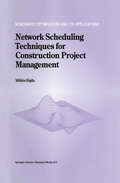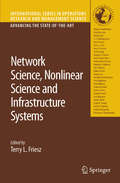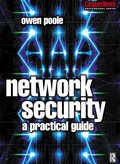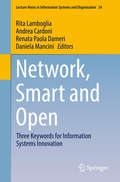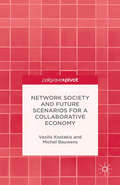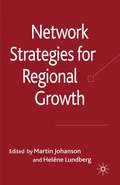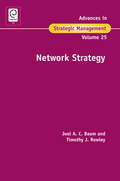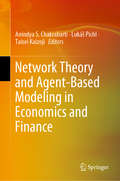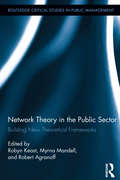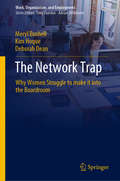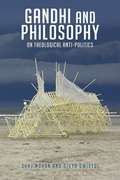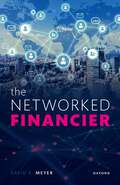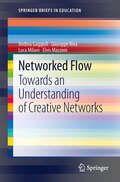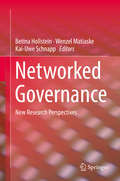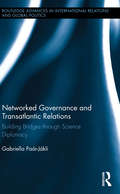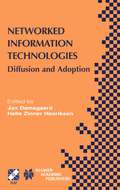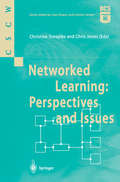- Table View
- List View
Network Scheduling Techniques for Construction Project Management (Nonconvex Optimization and Its Applications #16)
by M. HajduIndustrial, financial, commercial or any kinds of project have at least one common feature: the better organized they are, the higher the profit or the lower the cost. Project management is the principle of planning different projects and keeping them on track within time, cost and resource constraints. The need for effective project management is ever-increasing. The complexity of the environment we live in requires more sophisticated methods than it did just a couple of decades ago. Project managers might face insurmountable obstacles in their work if they do not adapt themselves to the changing circumstances. On the other hand, better knowledge of project management can result in better plans, schedules and, last but not least, more contracts and more profit. This knowledge can help individuals and firms to stay alive in this competitive market and, in the global sense, utilize the finite resources of our planet in a more efficient way.
Network Science, Nonlinear Science and Infrastructure Systems (International Series in Operations Research & Management Science #102)
by Terry L. FrieszThis book is written by leading scholars in Network Science, Nonlinear Science and Infrastructure Systems, expressly to develop common theoretical underpinnings for better solutions to modern infrastructural problems. The book is dedicated to the formulation of infrastructural tools that will better solve problems from transportation networks to telecommunications, Internet, supply chains and more.
Network Security
by Owen PooleFirst Published in 2002. Routledge is an imprint of Taylor & Francis, an informa company.
Network Security
by Owen PooleFirst Published in 2002. Routledge is an imprint of Taylor & Francis, an informa company.
Network, Smart and Open: Three Keywords for Information Systems Innovation (Lecture Notes in Information Systems and Organisation #24)
by Rita Lamboglia Andrea Cardoni Renata Paola Dameri Daniela ManciniThis book presents a collection of original research papers addressing the relationship between information systems (IS) and innovation. “Open”, “Smart” and “Network” are three keywords that are currently guiding information systems (IS) innovation, enhancing IS potentialities and their ability to support decision-making processes. The book discusses the relevance of these three new concepts in connection with technological and organizational innovations (i.e. cloud, smart technologies and networking), and the role they play in the development of accounting and management information systems.The book’s primary aim is to investigate how these innovations could influence information systems (with a particular focus on accounting and management information systems) by enhancing their information potentialities and improving accounting methodologies, performance measurement systems, data management, information systems architectures, and external and internal reporting.The book is based on a selection of the best papers—original double-blind reviewed contributions—presented at the 2016 Annual Conference of the Italian Chapter of the Association for Information Systems (AIS).
Network Society and Future Scenarios for a Collaborative Economy
by V. Kostakis M. BauwensThis book builds on the idea that peer-to-peer infrastructures are gradually becoming the general conditions of work, economy, and society. Using a four-scenario approach, the authors seek to simplify possible outcomes and to explore relevant trajectories of the current techno-economic paradigm within and beyond capitalism.
Network Strategies for Regional Growth
by Martin Johanson Heléne LundbergIn many regions the current focus of the state is to initiate and stimulate the emergence of inter-firm networks in order to produce growth. This book takes a management perspective on the operations and processes in these networks and describes and analyzes how and why geographical proximity influences inter-firm networks.
Network Strategy (Advances in Strategic Management #25)
by Joel Baum Tim RowleyResearch at the intersection of social networks and strategic management identifies a range of performance-enhancing network position advantages - access to partners, information, innovation, and resources - that are distributed differentially across network positions. While research indicates how network positions can be used to advantage, it says little about how these positions are established, sustained, and destroyed, and so we know little about the role of actors' strategic goals and self-interests in shaping network structures."Volume 25 of Advances in Strategic Management" aims to inspire a shift from discussions of network effects to network processes. Each chapter contributes to the crafting of a more dynamic view that increases our understanding of the origins, evolution and decay of network structures, positions and their associated advantages.
Network Theory and Agent-Based Modeling in Economics and Finance
by Anindya S. Chakrabarti Lukáš Pichl Taisei KaizojiThis book presents the latest findings on network theory and agent-based modeling of economic and financial phenomena. In this context, the economy is depicted as a complex system consisting of heterogeneous agents that interact through evolving networks; the aggregate behavior of the economy arises out of billions of small-scale interactions that take place via countless economic agents. The book focuses on analytical modeling, and on the econometric and statistical analysis of the properties emerging from microscopic interactions. In particular, it highlights the latest empirical and theoretical advances, helping readers understand economic and financial networks, as well as new work on modeling behavior using rich, agent-based frameworks. Innovatively, the book combines observational and theoretical insights in the form of networks and agent-based models, both of which have proved to be extremely valuable in understanding non-linear and evolving complex systems. Given its scope, the book will capture the interest of graduate students and researchers from various disciplines (e.g. economics, computer science, physics, and applied mathematics) whose work involves the domain of complexity theory.
Network Theory in the Public Sector: Building New Theoretical Frameworks (Routledge Critical Studies in Public Management)
by Robyn Keast Myrna Mandell Robert AgranoffNetworks have been described in terms of metaphors, governance arrangements and structural or institutional arrangements. These different perspectives of networks come out of a variety of disciplines, including political science, public administration, urban affairs, social welfare, public management and organizational/sociological research. This wealth of research, while contributing to a deeper understanding of networks, presents a dilemma which is addressed by this book. That is the question of whether there is a theory of public networks that informs networks in their various forms, and is there a need for a new theory of networks? More importantly, is network research still relevant to practice? Does network theory improve the process of governance? Are different terms and/or approaches actually the same or different? What do these different approaches mean to theory? This book deeply explores and integrates existing network theory and related theories from a number of perspectives, levels and jurisdictions to develop a framework to guide network design, governance and management. The book focuses on the important issue of network performance, looking at networks as bounded and consciously arranged; the actors who participate in them design the relationships among a bounded set of individual organizations to purse common objectives. Finally, the chapters tease out the variety of governance modes or regimes that intersect with network governance. This book offers a comprehensive, integrative, interdisciplinary approach that enables specialists, practitioners and administrators across a wide array of interests and fields to formulate and work on problems using a common language, analytical framework and theoretical basis.
Network Theory in the Public Sector: Building New Theoretical Frameworks (Routledge Critical Studies in Public Management)
by Robyn Keast Myrna P. Mandell Robert AgranoffNetworks have been described in terms of metaphors, governance arrangements and structural or institutional arrangements. These different perspectives of networks come out of a variety of disciplines, including political science, public administration, urban affairs, social welfare, public management and organizational/sociological research. This wealth of research, while contributing to a deeper understanding of networks, presents a dilemma which is addressed by this book. That is the question of whether there is a theory of public networks that informs networks in their various forms, and is there a need for a new theory of networks? More importantly, is network research still relevant to practice? Does network theory improve the process of governance? Are different terms and/or approaches actually the same or different? What do these different approaches mean to theory? This book deeply explores and integrates existing network theory and related theories from a number of perspectives, levels and jurisdictions to develop a framework to guide network design, governance and management. The book focuses on the important issue of network performance, looking at networks as bounded and consciously arranged; the actors who participate in them design the relationships among a bounded set of individual organizations to purse common objectives. Finally, the chapters tease out the variety of governance modes or regimes that intersect with network governance. This book offers a comprehensive, integrative, interdisciplinary approach that enables specialists, practitioners and administrators across a wide array of interests and fields to formulate and work on problems using a common language, analytical framework and theoretical basis.
The Network Trap: Why Women Struggle to Make it into the Boardroom (Work, Organization, and Employment)
by Meryl Bushell Kim Hoque Deborah DeanAs we begin the third decade of the twenty-first century, women have entered the workplace in unprecedented numbers, are now outperforming men in terms of educational qualifications, and are excelling across a range of professional fields. Yet men continue to occupy the positions of real power in large corporations.This book draws on unique, unprecedented access to Chairs of FTSE 350 Chairs, boardroom aspirants and executive head-hunters, to explain why this is the case.The analysis it presents establishes that the relative absence of women in boardroom roles is not explained by their lack of relevant skills, experience or ambition, but instead by their exclusion from the powerful male-dominated networks of key organisational decision-makers. It is from within these networks that candidates are sourced, endorsed, sponsored, and championed. Yet women’s efforts to penetrate these networks are instead likely to trap them into network relationships that will be of little value in helping them to fulfil their career aspirations.The analysis also identifies why women struggle to gain access to these networks, and in doing so, it demonstrates that the network trap in which women find themselves will not be overcome simply by encouraging them to change their networking behaviours. Instead, there is a need for a fundamental reconsideration of how boardroom recruitment and selection is conducted and regulated, to ensure the development of a more open, transparent and equitable process.
Network with Confidence: How to Benefit from your Business Contacts (Steps to Success)
by Daphne CliftonAre you fed up with trawling round networking events that take vast amounts of time for little return? Do you feel queasy stepping into a room of total strangers to represent yourself or your business? Then this is the book you've been waiting for.Networking is something that can really improve our career prospects, but it is something that many people actively dread. With advice on how to conquer your nerves, ask the right questions, find out about the right events (and work out which ones to avoid), this book offers a straightforward approach to networking that will build confidence in basic skills, as well as tips to hone the skills of the most seasoned networkers.
Network Your Way To Success: The secrets of successful business relationships
by John TimperleyDo you know enough people who could refer work to you? Are you great at following up contacts from events you attend? Do you know the secrets of making a real impact on those you meet?Effective networking is vital to the success of organisations - and the individuals who work in them. Most people are poor networkers, but it's easy to improve your skills. By following John Timperley's simple networking strategies, and the techniques of the world's top connecters, you will quickly learn how to build your own network of useful contacts.Discover how to polish your communication skills, create a lasting impression, quickly build your network, use your contacts database effectively, enjoy your new friends and contacts - and maximise your chances of success.
Networked Consumers: Dynamics of Interactive Consumers in Structured Environments
by Steven SilverPersonal consumption accounts for two thirds of GDP, yet recent economic events have emphasised our limited ability to translate consumption patterns into policy. Steven Silver analyses this understudied area, exploring the network memberships that emerge from our everyday lives, and the consumption patterns these create.
The Networked Financier
by David R. MeyerThe Networked Financier offers an explanation of the individual network behaviour of major financiers across diverse sectors and leading global financial centres. It argues that experienced financiers leverage their social capital to operate as 'networked financiers'. The few prior studies of the network behavior of individual financiers typically focus on one sector or on one financial centre. This book draws on Meyer's unique database of digitally recorded personal interviews with 167 financiers in London, Zurich, New York, Hong Kong, Singapore, Shanghai, Beijing, and Mumbai. They work in the sectors of corporate and investment banking, hedge funds, private equity, venture capital, fund management, real estate investment, insurance, and private banking. Extensive quotes are the mechanism for financiers to explain how they behave. Social network theory provides the lens for interpreting that behavior. The results demonstrate the validity of the theory for explaining financier network behavior. The book also contributes to a practical understanding of how financiers behave in networks because the interviewees explain their behaviour in their own words. By revealing the network behavior of leading financiers in major global business centres, the book provides a template about how sophisticated financiers behave.
The Networked Financier
by David R. MeyerThe Networked Financier offers an explanation of the individual network behaviour of major financiers across diverse sectors and leading global financial centres. It argues that experienced financiers leverage their social capital to operate as 'networked financiers'. The few prior studies of the network behavior of individual financiers typically focus on one sector or on one financial centre. This book draws on Meyer's unique database of digitally recorded personal interviews with 167 financiers in London, Zurich, New York, Hong Kong, Singapore, Shanghai, Beijing, and Mumbai. They work in the sectors of corporate and investment banking, hedge funds, private equity, venture capital, fund management, real estate investment, insurance, and private banking. Extensive quotes are the mechanism for financiers to explain how they behave. Social network theory provides the lens for interpreting that behavior. The results demonstrate the validity of the theory for explaining financier network behavior. The book also contributes to a practical understanding of how financiers behave in networks because the interviewees explain their behaviour in their own words. By revealing the network behavior of leading financiers in major global business centres, the book provides a template about how sophisticated financiers behave.
Networked Flow: Towards an Understanding of Creative Networks (SpringerBriefs in Education)
by Andrea Gaggioli Giuseppe Riva Luca Milani Elvis MazzoniIdentifying ‘networked flow’ as the key driver of networked creativity, this new volume in the Springer Briefs series deploys concepts from a range of sub-disciplines in psychology to suggest ways of optimizing the innovative potential of creative networks. In their analysis of how to support these networks, the contributing authors apply expertise in experimental, social, cultural and educational psychology. They show how developing a creative network requires the establishment of an optimal group experience in which individual intentions inform and guide collective goals. The volume represents a three-fold achievement. It develops a ground-breaking new perspective on group creativity: the notion of ‘networked flow’ as a bridging concept linking the neuropsychological, psychological and social levels of the creative process. In addition, the authors set out a six-stage model that provides researchers with a methodological framework (also by referring to the social network analysis) for studying the creativity traditionally associated with interpersonal contexts. Finally, the book includes perceptive analysis of the novel possibilities opened up by second-generation internet technologies, particularly in social networking, that seem destined to develop and sustain online creativity. As a wide-ranging exposition of a new direction in theoretical psychology that is laden with exciting possibilities, this volume will inform and inspire professionals, scholars and students alike.
Networked Governance: New Research Perspectives
by Betina Hollstein Wenzel Matiaske Kai-Uwe SchnappThis edited volume seeks to explore established as well as emergent forms of governance by combining social network analysis and governance research. In doing so, contributions take into account the increasingly complex forms which governance faces, consisting of different types of actors (e.g. individuals, states, economic entities, NGOs, IGOs), instruments (e.g. law, suggestions, flexible norms) and arenas from the local up to the global level, and which more and more questions theoretical models that have focused primarily on markets and hierarchies. The topics addressed in this volume are processes of coordination, arriving at and implementing decisions taking place in network(ed) (social) structures; such as governance of work relations, of financial markets, of innovation and politics. These processes are investigated and discussed from sociologists’, political scientists’ and economists’ viewpoints.
Networked Governance and Transatlantic Relations: Building Bridges through Science Diplomacy (Routledge Advances in International Relations and Global Politics)
by Gabriella Paar-JakliIn today’s complex and interconnected world, scholars of international relations seek to better understand challenges spurred by intensified global communication and interaction. The complex connectedness of modern society and politics compels us to investigate the pattern of interconnections among actors who inhabit social and political spaces. Gabriella Paár-Jákli's study aims to advance theory and practice by examining the networks used by specialists in North America and Europe to achieve their policy goals in the area of science and technology. Her book suggests that to overcome policy problems transnationally, three critical factors should be considered. First, as science and technology policy becomes increasingly critical to resolving global issues, it should be regarded as an integral element of the foreign policy process. Second, as liberal international relations theory argues, the increasing role of NGOs must be taken seriously alongside states as vital agents of policy reform. Third, as transatlantic relations remain center to maintaining the global order, they must be reconsidered. Paar-Jakli assesses the role of digital networks as facilitators of regional cooperation. Utilizing various techniques of social network analysis, her research indicates an active and structurally discernible network in cyberspace among transatlantic organizations, and demonstrates the role of virtual networks as facilitators of cooperative arrangements in transatlantic relations. Paár-Jákli's original research uses social network analysis to investigate transatlantic cooperation, a new approach that will be noteworthy to network and transatlantic scholars as well as policymakers.
Networked Governance and Transatlantic Relations: Building Bridges through Science Diplomacy (Routledge Advances in International Relations and Global Politics)
by Gabriella Paar-JakliIn today’s complex and interconnected world, scholars of international relations seek to better understand challenges spurred by intensified global communication and interaction. The complex connectedness of modern society and politics compels us to investigate the pattern of interconnections among actors who inhabit social and political spaces. Gabriella Paár-Jákli's study aims to advance theory and practice by examining the networks used by specialists in North America and Europe to achieve their policy goals in the area of science and technology. Her book suggests that to overcome policy problems transnationally, three critical factors should be considered. First, as science and technology policy becomes increasingly critical to resolving global issues, it should be regarded as an integral element of the foreign policy process. Second, as liberal international relations theory argues, the increasing role of NGOs must be taken seriously alongside states as vital agents of policy reform. Third, as transatlantic relations remain center to maintaining the global order, they must be reconsidered. Paar-Jakli assesses the role of digital networks as facilitators of regional cooperation. Utilizing various techniques of social network analysis, her research indicates an active and structurally discernible network in cyberspace among transatlantic organizations, and demonstrates the role of virtual networks as facilitators of cooperative arrangements in transatlantic relations. Paár-Jákli's original research uses social network analysis to investigate transatlantic cooperation, a new approach that will be noteworthy to network and transatlantic scholars as well as policymakers.
The Networked Health-Relevant Factors for Office Buildings: The Planned Health
by Werner Seiferlein Christine KohlertPeople who work in an office spend at least a third of their lifetime in these spaces. The planning of office and administration buildings can therefore contribute a great deal to the satisfaction and well-being of future users. The book looks at the health-relevant factors that affect people in office and administration buildings and therefore deserve special attention in the planning process. In doing so, the authors are guided by a concept of health as defined by the World Health Organization: Accordingly, health encompasses mental as well as social and physical well-being and thus goes far beyond the factors laid down in legal norms and guidelines. In this volume, architects and designers, physicians and ergonomists deal with all aspects of interior design seen from a health perspective: What role does colour design play, what significance do light, air and noise have? What does a demand-oriented building technology look like and how is the office furniture adequately designed? Which medical and hygienic aspects have to be considered? How can offices be designed in terms of work-life balance and how will the office change in the course of digitalisation? The book serves as a guideline that can be applied chapter by chapter in the planning of health-promoting office spaces - depending on the interests of the reader. Problems that arise are discussed using examples, and checklists help you with planning and implementation. The guide is aimed at building owners, architects, engineers, but also at lawyers, psychologists and doctors as well as university members in the field of economics and engineering.
The Networked Health-Relevant Factors for Office Buildings: The Planned Health
by Werner Seiferlein Christine KohlertPeople who work in an office spend at least a third of their lifetime in these spaces. The planning of office and administration buildings can therefore contribute a great deal to the satisfaction and well-being of future users. The book looks at the health-relevant factors that affect people in office and administration buildings and therefore deserve special attention in the planning process. In doing so, the authors are guided by a concept of health as defined by the World Health Organization: Accordingly, health encompasses mental as well as social and physical well-being and thus goes far beyond the factors laid down in legal norms and guidelines. In this volume, architects and designers, physicians and ergonomists deal with all aspects of interior design seen from a health perspective: What role does colour design play, what significance do light, air and noise have? What does a demand-oriented building technology look like and how is the office furniture adequately designed? Which medical and hygienic aspects have to be considered? How can offices be designed in terms of work-life balance and how will the office change in the course of digitalisation? The book serves as a guideline that can be applied chapter by chapter in the planning of health-promoting office spaces - depending on the interests of the reader. Problems that arise are discussed using examples, and checklists help you with planning and implementation. The guide is aimed at building owners, architects, engineers, but also at lawyers, psychologists and doctors as well as university members in the field of economics and engineering.
Networked Information Technologies: Diffusion and Adoption (IFIP Advances in Information and Communication Technology #138)
by Jan Damsgaard Helle Zinner HenriksenSoftware systems that used to be relatively autonomous entities such as e.g. accounting systems, order-entry systems etc. are now interlinked in large networks comprising extensive information infrastructures. What earlier used to be stand-alone proprietary systems are now for the most part replaced by more or less standardized interdependent systems that form large networks of production and use. Organizations have to make decisions about what office suite to purchase? The easiest option is to continuously upgrade the existing office suite to the latest version, but the battle between WordPerfect and Microsoft Word demonstrated that the choice is not obvious. What instant messenger network to join for global communication? Preferably the one most colleagues and friends use; AOL Instant Messenger, Microsoft Messenger, and ICQ represent three satisfactory, but disjunctive alternatives. Similarly organizations abandon their portfolio of homegrown IT systems and replace them with a single Enterprise Resource Planning (ERP) system. Several ERP alternatives exist on the market, but which is the right one for you? The argumentation and rationale behind these considerations are obviously related to the technological and social networks we are embedded in, but it is not always easy to specify how. Networked Information Technologies: Diffusion and Adoption offers contributions from academics and practitioners who study networked information systems from a diffusion and adoption point of view. Themes related to the conceptualisation of diffusion and adoption of networked information systems are discussed along with studies of the diffusion of networked information systems in public sector institutions and private businesses. This volume contains the edited proceedings of the IFIP Conference on The Diffusion and Adoption of Networked Information Technologies, which was sponsored by the International Federation for Information Processing (IFIP) Working Group 8.6 and held in Copenhagen, Denmark in October 2003.
Networked Learning: Perspectives and Issues (Computer Supported Cooperative Work)
by Christine Steeples Christopher JonesHere, the authors' unique focus is on the key issues of networked learning. These include: policy issues, the costs of networked learning, staff development issues, and the student experience. With contributions from authors based in Europe and the US and Australia, it offers a global perspective which is designed to inform professional practice and its administration. It will be essential reading for practitioners and researchers in higher education and learning technology and will be of interest to policy-makers and managers in HE academic administration. It will also be relevant to learning technologists, support staff, as well as students and researchers in education and social science.
